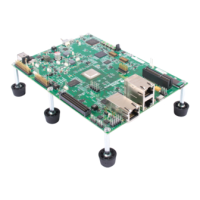Functional Description
www.ti.com
11.3.10 Memory Protection
The EDMA3 channel controller supports two kinds of memory protection: active and proxy.
11.3.10.1 Active Memory Protection
Active memory protection is a feature that allows or prevents read and write accesses (by any EDMA3
programmer) to the EDMA3CC registers (based on permission characteristics that you program). Active
memory protection is achieved by a set of memory protection permissions attribute (MPPA) registers.
The EDMA3CC register map is divided into three categories:
• a global region.
• a global channel region.
• eight shadow regions.
Each shadow region consists of the respective shadow region registers and the associated PaRAM. For
more detailed information regarding the contents of a shadow region, refer to section Table 11-11.
Each of the eight shadow regions has an associated MPPA register (MPPAn) that defines the specific
requestor(s) and types of requests that are allowed to the regions resources.
The global channel region is also protected with a memory-mapped register (MPPAG). The MPPAG
applies to the global region and to the global channel region, except the other MPPA registers themselves.
For more detailed information on the list of the registers in each region, refer to the register memory-map
in section Table 11-18.
See Section 11.4.1.5.4 for the bit field descriptions of MPPAn. The MPPAn have a certain set of access
rules.
Table 11-17 shows the accesses that are allowed or not allowed to the MPPAG and MPPAn. The active
memory protection uses the PRIV and PRIVID attributes of the EDMA programmer. The PRIV is the
privilege level (i.e., user vs. supervisor). The PRIVID refers to a privilege ID with a number that is
associated with an EDMA3 programmer. See the device-specific data manual for the PRIVIDs that are
associated with potential EDMA3 programmers.
Table 11-17. Allowed Accesses
Access Supervisor User
Read Yes Yes
Write Yes No
Table 11-18 describes the MPPA register mapping for the shadow regions (which includes shadow region
registers and PaRAM addresses).
The region-based MPPA registers are used to protect accesses to the DMA shadow regions and the
associated region PaRAM. Because there are eight regions, there are eight MPPA region registers
(MPPA[0-7]).
Table 11-18. MPPA Registers to Region Assignment
Register Registers Protect Address Range PaRAM Protect
(1)
Address Range
MPPAG Global Range 0000h-1FFCh N/A N/A
MPPA0 DMA Shadow 0 2000h-21FCh 1st octant 4000h-47FCh
MPPA1 DMA Shadow 1 2200h-23FCh 2nd octant 4800h-4FFCh
MPPA2 DMA Shadow 2 2400h-25FCh 3rd octant 5000h-57FCh
MPPA3 DMA Shadow 3 2600h-27FCh 4th octant 5800h-5FFCh
MPPA4 DMA Shadow 4 2800h-29FCh 5th octant 6000h-67FCh
MPPA5 DMA Shadow 5 2A00h-2BFCh 6th octant 6800h-6FFCh
MPPA6 DMA Shadow 6 2C00h-2DFCh 7th octant 7000h-77FCh
MPPA7 DMA Shadow 7 2E00h-2FFCh 8th octant 7800h-7FFCh
(1)
The PARAM region is divided into 8 regions referred to as an octant.
908
Enhanced Direct Memory Access (EDMA) SPRUH73H–October 2011–Revised April 2013
Submit Documentation Feedback
Copyright © 2011–2013, Texas Instruments Incorporated

